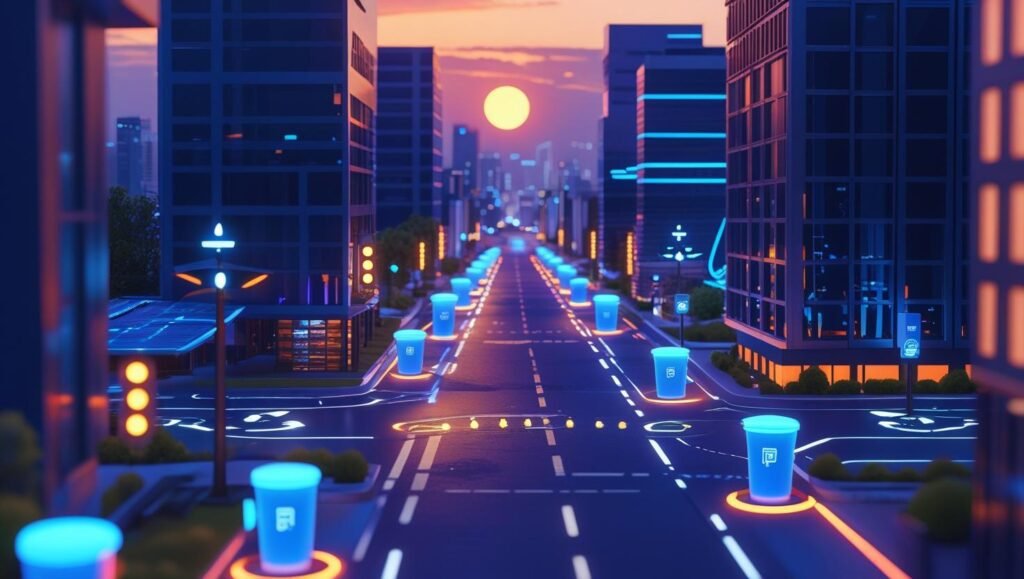Urban IoT Revolutionizes Smart City Infrastructure Now

Cities are growing fast, and so are their challenges. Traffic jams, energy waste, and safety concerns are just a few issues urban areas face. But there’s good news: Urban IoT (Internet of Things) is changing how cities work, making them smarter and more efficient. By connecting devices, sensors, and systems, Urban IoT helps cities solve problems and improve life for everyone. In this blog post, we’ll explore how Urban IoT is revolutionizing smart city infrastructure right now and why it matters to you.
What is Urban IoT?
Urban IoT is all about using connected devices to make cities better. Think of sensors on streetlights, traffic cameras, or even trash bins that talk to each other through the internet. These devices collect data and share it to help city planners make smarter decisions. For example, a sensor might tell the city when a trash bin is full, so trucks only pick it up when needed, saving time and fuel.
This technology isn’t just fancy gadgets—it’s about solving real problems. Urban IoT helps cities save money, reduce waste, and keep people safe. It’s already being used in places like Singapore and Barcelona to create smarter, greener urban spaces.
Why Urban IoT Matters
Why should you care about Urban IoT? Because it makes your daily life easier. Whether you’re stuck in traffic or waiting for a bus, IoT solutions can help. Here are a few reasons why Urban IoT is a game-changer:
- Saves time: Smart traffic lights adjust to traffic flow, reducing wait times.
- Cuts costs: Cities use less energy with smart lighting and water systems.
- Improves safety: Sensors detect hazards like floods or air pollution early.
- Boosts sustainability: IoT helps reduce waste and promotes green living.
How Urban IoT Powers Smart Cities
Smart cities rely on Urban IoT to function smoothly. Let’s dive into some key areas where this technology is making a difference.
Smart Traffic Management
Traffic is a headache in most cities. Urban IoT helps by using sensors and cameras to monitor roads in real time. For example, smart traffic lights can change timing based on traffic flow, reducing congestion. In some cities, apps use IoT data to suggest faster routes to drivers.
This saves you time and reduces stress. Plus, less idling means fewer emissions, which is better for the environment. Cities like Los Angeles are already using Urban IoT to cut down traffic jams.
Energy-Efficient Buildings
Buildings use a lot of energy, but Urban IoT is changing that. Smart sensors control lighting, heating, and cooling based on need. For instance, an office building might dim lights in empty rooms or turn off air conditioning at night. This cuts energy bills and helps the planet.
In smart cities, entire neighborhoods use Urban IoT to share energy data. This helps balance energy use across the city, preventing blackouts and reducing waste.
Waste Management Made Smarter
Trash collection can be inefficient. Urban IoT fixes this by putting sensors in bins to track how full they are. When a bin is nearly full, it sends a signal to the waste management team. This means trucks only go where they’re needed, saving fuel and time.
In places like Seoul, Urban IoT has cut waste collection costs by up to 20%. It also keeps streets cleaner, making cities more pleasant to live in.
Public Safety and Security
Safety is a top priority in any city. Urban IoT helps by using cameras, sensors, and alarms to monitor public spaces. For example, smart streetlights can detect unusual activity at night and alert authorities. Flood sensors can warn about rising water levels before disaster strikes.
These systems make neighborhoods safer and give residents peace of mind. Urban IoT is like an extra set of eyes, keeping watch over the city.
Real-World Examples of Urban IoT in Action
Urban IoT isn’t just a future dream—it’s happening now. Here are some exciting examples:
- Singapore: This city uses Urban IoT for smart parking. Sensors guide drivers to open parking spots, reducing circling and congestion.
- Barcelona: Smart water meters track usage, helping the city save millions of gallons of water each year.
- Toronto: Urban IoT sensors monitor air quality, alerting residents to pollution spikes so they can stay safe.
These examples show how Urban IoT is already improving lives. It’s not just about tech—it’s about making cities more livable.
Challenges of Urban IoT
While Urban IoT is amazing, it’s not perfect. There are some hurdles to overcome:
- Cost: Setting up IoT systems can be expensive for cities with tight budgets.
- Privacy: Collecting data raises concerns about how it’s used and who sees it.
- Maintenance: Sensors and devices need regular updates to stay reliable.
Despite these challenges, the benefits of Urban IoT outweigh the drawbacks. Cities are finding ways to address these issues, like using secure data systems and planning for long-term maintenance.

How Urban IoT Benefits You
You might be wondering, “How does Urban IoT affect me?” It’s simple—it makes your life better in small and big ways. Imagine shorter commutes because of smarter traffic systems. Picture cleaner streets thanks to efficient waste collection. Think about safer parks and public spaces with IoT monitoring.
Urban IoT also saves cities money, which can mean lower taxes or better public services. Plus, it helps the environment by cutting waste and energy use, so future generations inherit a healthier planet.
What’s Next for Urban IoT?
The future of Urban IoT is bright. As technology improves, we’ll see even more exciting changes. For example, self-driving cars could use IoT to communicate with traffic systems, making roads safer. Smart grids could make energy use even more efficient. And as 5G networks grow, Urban IoT devices will share data faster, leading to quicker solutions.
Cities are just starting to tap into the power of Urban IoT. The possibilities are endless, and the impact will only grow.
A Closer Look: Urban IoT in Numbers
| Area | Impact of Urban IoT |
|---|---|
| Traffic Management | Reduces congestion by up to 15% |
| Energy Use | Cuts building energy costs by 20–30% |
| Waste Collection | Lowers operational costs by 10–20% |
| Public Safety | Decreases response time to incidents by 25% |
This table shows just how powerful Urban IoT can be. These numbers come from real cities using IoT to solve problems. The results speak for themselves—Urban IoT is making a big difference.
Conclusion
Urban IoT is transforming cities into smarter, more efficient places to live. From reducing traffic jams to saving energy and keeping streets safe, this technology is solving real-world problems. It’s not just about fancy gadgets—it’s about making your life easier and your city better. As Urban IoT grows, expect even more exciting changes that improve how we live, work, and play in urban areas.
Ready to see Urban IoT in action? Keep an eye on your city’s projects, or check out what places like Singapore and Barcelona are doing. The smart city revolution is here, and it’s only getting better!
FAQs
What is Urban IoT?
Urban IoT uses connected devices like sensors and cameras to collect data and improve city services, like traffic, energy, and waste management.
How does Urban IoT make cities safer?
It uses sensors and cameras to monitor public spaces, detect hazards like floods, and alert authorities to unusual activity.
Is Urban IoT expensive for cities?
It can be costly to set up, but it saves money in the long run by reducing waste, energy use, and operational costs.
Can Urban IoT help the environment?
Yes! It cuts energy use, reduces emissions, and improves waste management, making cities greener and more sustainable.
Read more: https://iotinsightshub.com/iot-firmware-security-top-threats-and-fixes-for-2025/

